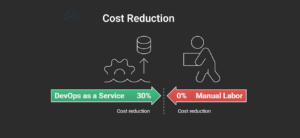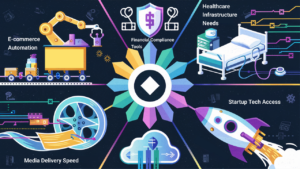Introduction
The modern digital environment demands swift delivery of top-tier software at maximum efficiency from both large and small companies. Business success now requires organizations to release upgraded applications speedily ahead of their market competitors because technology advancements and consumer expectations continue to change uncontrolled. Businesses both small and large conduct software development process changes to sustain their competitive position in this dynamic environment.
DevOps as a Service (DaaS) is emerging as the solution that addresses current market needs. DevOps technology, through its modern approach, brings simplified operations by providing complete cloud service management of robust development tools and infrastructure. DaaS unites isolated teams and ensures an automated workflow structure that makes processes more rapid and agile while improving collaboration between departments.
DevOps has existed for more than ten years, but the release of “as a Service” concepts establishes major transformations. Developing beyond automation requires businesses to build fluid teamwork structures while maximizing infrastructure performance and speeding up delivery cycles without requiring complete in-house administration.
Your organization needs to understand what DevOps as a Service delivers to benefit from its potential to transform in the competitive digital economy.
What is DevOps as a Service?
Companies employ DevOps as a Service as their cloud-based delivery model to distribute a complete managed DevOps toolchain in one service. Firms avoid developing and supporting their DevOps infrastructure by obtaining expert services from external firms with deep DevOps abilities. The external experts unite diverse development and operations tools, including code repositories and CI/CD systems, while infrastructure automation platforms allow them to provide an individualized end-to-end DevOps pipeline for business requirements.
Businesses that adopt this approach do not require management of tool compatibility, together with security patches and infrastructure scaling, as well as performance monitoring. DevOps as a Service allows organizations to free up their in-house teams and enable them to work on innovation because the service takes care of critical aspects like continuous integration alongside automated deployment, and real-time monitoring of performance, alongside infrastructure provisioning.
The move to service-based operations drives both improved speed of software delivery and decreased operational expenses and complexity. Thanks to service-based DevOps solutions, organizations of all company sizes can now benefit from this strategy, which simplifies the implementation of best practices and consistent operation scaling.
The Traditional DevOps Model vs. DevOps as a Service

An understanding of DaaS uniqueness arises through its comparison with standard DevOps development.
Organizations traditionally dedicate time and funding to create and oversee their infrastructure alongside developing their tools, alongside assemble their teams. The ability to customize and manage operations comes at the expense of requiring professional expertise and continuous updates, and maintaining proper coordination.
DevOps as a Service provides cloud-native solutions before implementing them into your current framework. DevOps consulting services supply clients with automated maintenance and tracking systems backed by a streamlined professional service solution.
The solution removes the requirement for businesses to start from scratch. The adoption of mature DevOps practices is possible right from inception, with an option to extend them at the required capacity.
How DevOps as a Service Transforms Business Infrastructure
DaaS provides its most valuable benefit through its power to modify fundamental digital system components. Let’s break it down.
1. Faster Time to Market
The main benefit of DevOps as a Service includes accelerated performance. Services that offer automatic DevOps pipelines allow businesses to dramatically reduce their software delivery times. Despite handling software testing along with integration and deployment through automation tools, the main development team maintains focus on both enhancing user experience and writing new code.
Increased delivery speed creates two main benefits: enhanced productivity and faster market response, which establishes superior competitiveness for companies.
2. Improved Collaboration and Transparency
The underlying success factor of DevOps exists in keeping operations working side by side with developers. The additional advantages of DaaS come from unified workflow management and complete software development tracking. All teams acquire real-time access to dashboards together with logs and metrics that let them maintain transparency and hold each other accountable.
Effective communication and real-time data enable cross-functional teams to fix problems swiftly and keep their direction consistent from the start of planning until production release.
3. Scalable and Flexible Infrastructure
DevOps as a Service gains its fundamental advantages from its ability to scale. The growth of your business requires your infrastructure to transform. The deployment of cloud-native environments by DaaS providers allows scalable operations that ensure continuous service availability during all types of growth.
The system infrastructure executes automatic adjustments to match your growing needs, including new microservice deployments and increased user base, and multi-region deployments.
4. Continuous Integration and Continuous Delivery (CI/CD)
Modern DevOps strategies depend on CI/CD operating as their primary life force. Programs managed by DaaS providers establish sophisticated CI/CD pipelines to connect code automatically for testing and delivery without the need for frequent human operator involvement.
The automated system for building applications, together with instant testing followed by automatic deployment, minimizes operational bugs in production. The practice provides better software quality while earning customer trust over time.
5. Enhanced Security and Compliance
Security must be top of mind since finance and healthcare, and e-commerce organizations require it. DevOps as a Service adds security at each phase of the delivery pipeline.
DaaS providers utilize integrated tools to both scan vulnerabilities and manage access control and track compliance standards as part of their approach to building applications with built-in security measures. Risk reduction occurs through continuous auditing and anomaly detection as well as through the practice of logging operations.
Why Businesses Are Turning to DevOps Consulting Companies
The establishment of internal DevOps culture remains possible yet impractical for startup organizations, together with businesses that lack extensive technical capabilities. Organizations seek help from DevOps consulting companies to implement their DevOps programs because of this need.
DevOps specialists provide organizations with their accumulated knowledge about establishing secure and expandable DevOps systems. These consultants possess the knowledge to choose suitable tools and position environments, and automate workflows as well as performance monitoring.
The roadmap from DevOps consultants matches your organization’s targets as well as follows both your planned schedule and allocated finances. Using DevOps consultants proves to be a beneficial strategy because it reduces time requirements while minimizing errors to achieve a higher return on investment.
Key Components of a DevOps as a Service Pipeline
A specific DevOps pipeline built by design forms the core part of every DaaS solution and automates the process of code movement from development to deployment. The primary elements of DaaS delivery consist of:
– The version control system acts as a source control solution that handles project code changes together with team collaboration.
– A framework of Continuous Integration (CI) operates automated systems for programming code compilation, followed by testing to identify errors at an early stage.
– The system handles built code packages as artifacts that serve for steady deployment and distribution.
– The Continuous Delivery practice allows validated code to move forward automatically to either staging or production environments.
– The Infrastructure as Code (IaC) framework includes Terraform and Ansible among the available tools, which allow administrators to create and operate infrastructure through written code.
– The system provides real-time metrics together with logs for tracking the health and performance of the application.
– Security tools automate the process of detecting vulnerabilities that exist in both code and infrastructure
These elements form a dependable method that both lowers human mistakes and speeds up project development.
Industries Benefiting from DevOps as a Service

Any business operating digitally can use DaaS effectively, although specific sectors have demonstrated high interest in its adoption.
1. The e-commerce industry heavily depends on CI/CD and automated testing because it needs continuous updates along with high system availability.
2. The financial sector depends on DaaS for ensuring regulatory compliance while it simultaneously develops and introduces innovative features to customers.
3. Organizations dealing with healthcare need secure, scalable infrastructure along with HIPAA compliance requirements for their healthcare applications.
4. Media entertainment organizations deploy rapid delivery methods to stabilize their content platforms ahead of market competition.
5. Startups obtain enterprise-level tools from DaaS, which allows them to bypass both expensive internal development and complexity.
Challenges and Considerations
The clear advantages of DaaS need proper planning during the migration process.
1. The exclusive relationship with a single provider regarding services through Vendor Lock-In creates inflexibility in maintaining free choices in the future. Your company should work with vendors who provide open standards with easily transferable tools.
2. A provider needs to demonstrate strict security protocols before customers hand over infrastructure management responsibilities to ensure data protection.
3. The built-in solutions encounter limitations when trying to adapt to individual business requirements exactly. Your provider needs your collaboration to adjust the services specifically for your requirements.
Businesses accept these challenges because they outweigh the minimal speed and efficiency and reliability improvements gained through cloud migration.
The Future of DevOps as a Service
Businesses across every sector are implementing cloud computing while working remotely and transforming digitization, which increases the necessity for adaptable DevOps solutions. Organizations are set to adopt DaaS solutions as standard practice instead of choosing them rarely.
AI, together with machine learning systems, will expand its presence in optimizing DevOps processes. The commencing features of predictive analytics and auto-scaling, together with intelligent testing, represent the basic structure. The approaching DevOps tools generation will consist of highly integrated intelligent solutions that function at maximum speed.
The current moment presents businesses with an advantageous opportunity because those adopting DaaS solutions will surpass competitors who delay their implementation in this highly competitive business environment.
FAQs
1. What is DevOps as a Service (DaaS)?
Organizations receive DevOps tools and infrastructure management with the DevOps as a Service cloud-based delivery solution as a managed service. DevOps as a Service enables businesses to streamline development while automating deployments, along with improved collaboration through outside management of DevOps systems that eliminate internal building and maintenance requirements.
2. How does DevOps as a Service improve the DevOps pipeline?
The DevOps pipeline receives enhancement through DaaS when it consolidates continuous integration tools with delivery processes and testing capabilities, and monitoring functions to build an automatic workflow. The software deployment quality and speed of delivery expand, and manual work decreases as a result of this automation.
3. Why should companies work with DevOps consulting companies?
DevOps consulting companies offer expertise, tools, and best practices to help businesses implement DevOps quickly and efficiently. They can design customized pipelines, ensure security compliance, and optimize performance, especially valuable for companies without an in-house DevOps team.
4. Is DevOps as a Service suitable for small businesses and startups?
Absolutely. Startups, together with small businesses, achieve access to professional-level tools with automation they can use through DevOps as a Service without needing to invest in major capital expenses. The service enables businesses to bring their products to market more quickly while supporting their seamless expansion, while maintaining market competitiveness in the dynamic digital world.
Final Thoughts
DevOps as a Service represents a fundamental and permanent transformation in software development practices, which now controls business operations across deployment and software management. Organizations utilize DaaS services in this era to decrease operational costs while achieving speed, security, and scalability, which enables them to concentrate on valuable customer outcomes. Through ISO 2001-1 certified cloud-native tools, business users with expert consulting and automated pipelines accelerate their innovation rates while increasing operational efficiency through decreased costs and elevated quality standards.
DevOps as a Service becomes the ideal solution for conflicting organizations between startups pursuing speedy development and enterprise firms endeavoring to extend their legacy systems. Technical speed bumps that extend the development timeline get removed by agile automated workflows that help engineers achieve better reliability and speed up their cycles.
Do you like to read more educational content? Read our blogs at Cloudastra Technologies or contact us for business enquiry at Cloudastra Contact Us.